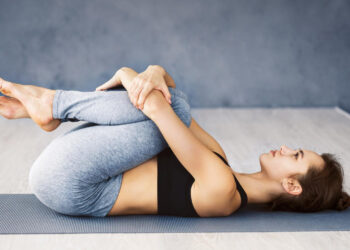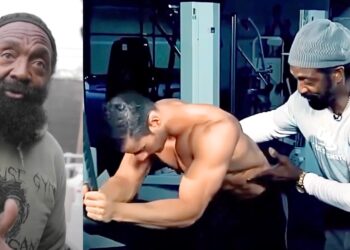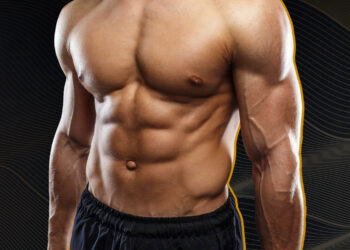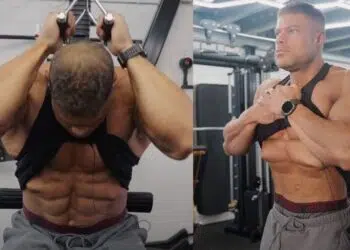If you’ve mastered basic crunches and lying leg lifts then it’s probably time to step up your ab workouts with a more advanced core training technique like the pull-in (on stability ball). Who’d have thought, but using an oversized beach ball really is one of the cheapest and most effective ways to challenge your midsection or any muscle for that matter. It adds two important functional elements – balance and stability – that you otherwise wouldn’t get with most ab exercises done on the floor, from a workout bench, or even while hanging from a bar.
Check out our complete guide on the pull-in (on stability ball) below for in-depth exercise instructions, tips, benefits, variations, and more.
How To Do Pull-Ins With Stability Ball
Before attempting the pull-in (on stability ball), make sure that you have a good quality Swiss ball that’s fully inflated. We also recommend performing the movement on a soft surface like carpet or mats to protect your knees from the floor.
Below we’ve provided step-by-step exercise instructions below to ensure safe and proper execution of this awesome core exercise.
Exercise instructions:
- Find an area with sufficient space and place your ball on the floor.
- Stand a few feet away from the ball facing in the opposite direction (looking away from the ball).
- Squat down and place your palms on the floor roughly hip to shoulder-width apart with the fingers pointed forward and arms fully extended (think position for a pushup).
- Extend one leg back and place your entire shin from the knee to the ankle on the ball, then do the same with your other leg so both legs are balancing on the ball. Keep your body straight and don’t allow your hips to sink down.
- Engage your core then roll the ball forward by pulling your knees toward your chest. Hold this position briefly.
- Extend your legs back out to the starting position and repeat this movement for the desired number of repetitions.
Here’s a video demonstration of the pull-in (on stability ball).
Pro tip: Crunch your upper body toward your knees for a more intense contraction in the abdominals.
Benefits
Why should you do pull-ins (on stability ball)? Let’s go over some of the awesome benefits of this core blaster.
Level Up Your Fitness: Join our 💪 strong community in Fitness Volt Newsletter. Get daily inspiration, expert-backed workouts, nutrition tips, the latest in strength sports, and the support you need to reach your goals. Subscribe for free!
Strengthen your core muscles
Everyone wants a flat, sexy tummy that they can show off during the summer months (and there’s nothing wrong with that). Ab training can help to build and strengthen the muscles of your midsection, but core training should aim to achieve more than that.
A strong and developed core is also important for stabilizing your spine and protecting your lower back during physical activities, healthy posture, aging, balance, and being able to perform everyday tasks well into our older years (1).
Keep your hips strong and mobile
While pull-ins are an ab-focused exercise, the hip flexors are also getting some action. These muscles are just as important for physical performance as they help maintain core stability, proper posture, and movement of the lower body muscles.
Train functionally
Again, the core muscles are crucial for supporting physical activities whether you’re an athlete, active person in general, or simply want to maintain a healthy body structure for as long as you can. The balance and stability required to maintain position on the ball makes this a functionally useful movement that transfers to actual real life situations.
Try these 10 Best BOSU Ball Exercises
Simple progression
By simple we mean blowing up a rubber ball. It’s really that simple to increase the difficulty of many different exercises that you can do for the upper, lower and core muscles.
5 Pull-In Variations
Check out some of the variations we recommend that range from easier to more challenging for different levels of training experience.
1. Stability ball leg extension crunch (Easiest)
One way that you can add more resistance with the stability ball is to lie on your back and perform leg lifts with the ball in between your legs. This alternative can be a good way to strengthen the same muscles but it’s especially useful if you’re not ready for pull-ins.
Here’s a quick guide to the stability ball leg crunch.
Level Up Your Fitness: Join our 💪 strong community in Fitness Volt Newsletter. Get daily inspiration, expert-backed workouts, nutrition tips, the latest in strength sports, and the support you need to reach your goals. Subscribe for free!
2. Single-leg pull-in on stability ball (Hardest)
If you’re plenty proficient with the two legged version of the pull-in (on stability ball), the next logical progression would be to do it while balancing on one foot. It will no doubt be harder to do but the benefits can be even greater.
3. Alternating pull-in
Similar to the above variation, you’ll perform the exercise with one leg on the ball at a time. However, instead of doing ten reps with one leg before switching to the other side, you’ll alternate the left and right leg for each set. For example, you’ll do one rep with the left leg (pull in and extend out) followed one rep with the right leg.
4. Pike pull-in
Similar to pike pushups, the idea is to lift your butt as high in the air as possible (your body should resemble an inverted “V”). This may engage the core muscles a little differently.
5. Pull-in / Pushup
If you’re already in a pushup position, why not be more efficient and train your upper body pushing muscles at the same time? You should already be capable of performing pushups before doing this variation, not to mention, having your feet elevated and balancing on the ball will make it even more challenging.
To do it:
- Set up in the same position as you would the pull-in with hands roughly shoulder-width apart and fingers pointed straight forward or slightly outward.
- Keep your butt raised and core tense, then bring your knees to your chest.
- Extend your legs back out, then bend your arms and lower your upper body to the ground. Keep your head neutral.
- Squeeze your chest muscles and push into the floor until your back in the starting position.
- Repeat for the desired number of reps.
Related: Swiss Ball Leg Workout for A Strong, Functional Lower Body
How To Incorporate Pull-Ins (on stability ball) Into Your Training Regime
As with any exercise, your level of training experience, goals, and training regime will determine how you incorporate them into your workouts. But here are a few suggestions for you.
Ab regime
A lot of people do a dedicated ab training workout and pull-ins can be a great addition if strategically added. Ideally, an effective core workout should include a variety of movements that include a hanging/leg raise variation (pull-ins can fit here), a top-down (crunch) exercise, top and bottom crunch variation (e.g., cocoons), and a rotational movement (e.g., Mason twist).
Circuit training
Because there’s very little setup required, pull-ins are a great core movement to add in your circuit workouts. This is a training method where multiple exercises are performed back to back with little to no rest in between.
Sets and Reps
While pull-ins do use a stability ball which makes them more challenging, they’re still a bodyweight-based exercise. So there’s no way to adjust the resistance. In this case we recommend training to within a few repetitions of failure for each set to really challenge the muscles.
Below is a general recommendation for sets and reps that should work for most people. Although, if you’re more advanced you’ll know what works best for your experience level and goals.
- 2-3 sets x 8-25 reps
Muscles Worked
The pull-in (on stability ball) involves several muscle groups all of which we’ve provided brief descriptions for below.

- Core/abs – Stability ball pull ins require a decently strong core which is the muscles in your midsection such as the rectus abdominis and deeper core muscles. They help to keep your trunk strong and rigid and prevent your hips from sinking down which is what you don’t want.
- Iliopsoas – Strong iliopsoas muscle is necessary for just about every lower body function. Being the strongest hip flexor, iliopsoas is comprised of a major, minor and a muscle called iliacus that can act separately or together.
- Pectineous – The pectineous is grouped with the hip adductor muscles. It flexes and adducts the thigh at the hips.
- Sartorius – The sartorius is an impressive muscle because it’s known to be the longest in the human body. Running down the length of the inner anterior thigh, this muscle crosses through both the hip and knee joints. However, it’s a weak hip and thigh flexor acting more as a synergistic muscle in the upper leg.
- Tensor Fasciae Latae – A thigh adductor muscle also attached to the glute area, the tensor fascia latae (TFL) assists in moving and stabilizing the hips and knees. It works with the gluteus medius and gluteus minimus to internally rotate and abducts the hip.
Bottom Line
Pull-ins (on a stability ball) are the perfect example of how you can elevate your training by adding something simple like an air-filled Swiss balls can be easily found for a price that most people can afford. Plus they’re an excellent functional training tool due to the instability of a rolling object which creates a unique challenge to the muscles.
We also recommend trying out all of the variations to get the most out of this bodyweight exercise.
Interested in measuring your progress? Check out our strength standards for Leg Extension, Squat, Hanging Leg Raise, and more.








